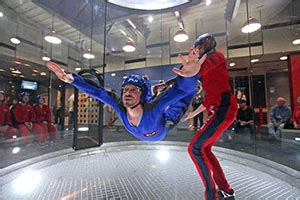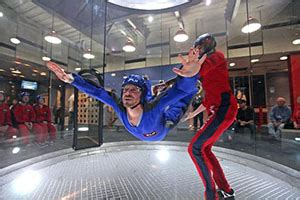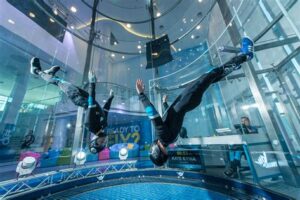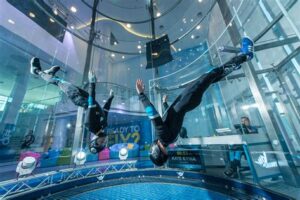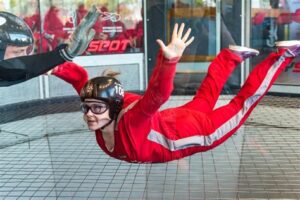Table of Contents
Indoor skydiving vs real skydiving: Discover the differences between these two exhilarating experiences. Indoor skydiving offers a controlled environment where you can experience the sensation of freefall, while real skydiving provides the ultimate thrill of jumping from an aircraft and soaring through the open sky. Explore the pros and cons of each option to choose the perfect adventure that suits your preferences and comfort level.
Are you ready to experience the thrill of freefalling through the sky? If so, you may be considering either indoor skydiving or real skydiving as your next adrenaline-pumping adventure. While both options offer a taste of the exhilarating sensation of flying through the air, they differ in several crucial aspects. Whether you’re seeking a controlled environment or a more authentic outdoor experience, it’s essential to weigh the pros and cons of each before taking the leap. In this article, we will explore the key differences between indoor skydiving and real skydiving, allowing you to make an informed decision and embark on an unforgettable journey. So, buckle up and let’s compare these two heart-racing activities!
Introduction
Welcome to this article comparing indoor skydiving and real skydiving. Whether you’re an adrenaline junkie or simply looking for a unique experience, skydiving offers an exhilarating adventure. However, there are two distinct ways to experience the thrill of freefall: indoor skydiving and real skydiving. In this article, we will explore the key differences and similarities between these two popular activities.
What is Indoor Skydiving?
Indoor skydiving, also known as vertical wind tunnel skydiving, simulates the sensation of freefall in a controlled environment. Participants enter a vertical wind tunnel, which generates a powerful updraft, allowing them to float effortlessly in mid-air. This activity is perfect for anyone seeking a taste of skydiving without the need for an airplane or parachute.
The Thrill of Real Skydiving
Real skydiving involves jumping from a high altitude with a parachute and experiencing the true adrenaline rush of freefall. After exiting the plane, skydivers reach terminal velocity, accelerating at around 120 mph. This is the epitome of thrill-seeking, offering breathtaking views and a profound sense of freedom.
Safety Considerations
When it comes to safety, both indoor skydiving and real skydiving have their own set of considerations. Indoor skydiving is generally considered safer since participants are in a controlled environment with professionals overseeing the experience. In contrast, real skydiving carries inherent risks due to factors such as weather conditions, parachute malfunctions, and landing hazards. However, real skydiving adheres to strict safety protocols, including thorough training and equipment checks, to minimize these risks.
Accessibility and Cost
Indoor skydiving offers a more accessible option for those who may have physical limitations or fear of heights. It can be enjoyed by people of all ages and abilities. Additionally, the cost of indoor skydiving is typically lower compared to real skydiving, making it a more affordable alternative for those on a budget.
Training and Preparation
Before participating in real skydiving, individuals must undergo extensive training to ensure they have the necessary knowledge and skills to jump safely. This includes learning how to properly operate a parachute, understanding body positioning during freefall, and practicing emergency procedures. Indoor skydiving, on the other hand, requires minimal training and preparation, as participants are guided by instructors inside the wind tunnel.
Social Experience
Real skydiving often brings people together, creating lifelong connections and camaraderie among skydivers. The shared experience of jumping out of a plane fosters a sense of community and bonding. Indoor skydiving, while still enjoyable, lacks the same social aspect as real skydiving since participants are typically not jumping simultaneously and are instead taking turns in the wind tunnel.
Environmental Impact
Real skydiving has a considerably larger environmental impact due to the use of airplanes and the associated carbon emissions. Indoor skydiving, being conducted within a wind tunnel, has a minimal environmental footprint. If reducing your carbon footprint is a concern, indoor skydiving offers a more sustainable option.
The Unique Sensations
Despite their differences, both indoor skydiving and real skydiving provide unique sensations. Indoor skydiving offers the feeling of floating on air, with the wind tunnel simulating the experience of freefall. Real skydiving, on the other hand, provides an unparalleled rush of adrenaline as you soar through the sky. The breathtaking views and connection with nature are truly unmatched.
Conclusion
Whether you choose indoor skydiving or real skydiving, both experiences offer their own brand of excitement and adventure. Indoor skydiving provides a controlled environment, accessibility, and affordability, while real skydiving offers an unmatched thrill and connection with nature. Ultimately, the choice comes down to personal preferences, physical abilities, and budget. Whichever you choose, prepare yourself for an unforgettable experience that will leave you with memories to last a lifetime.
Introduction
In this guide, we will explore the differences between indoor skydiving and real skydiving, providing you with valuable insights to help you decide which experience best suits your preferences and needs.
Safety Precautions
1.1 Indoor Skydiving:
Before entering the wind tunnel, ensure that you have removed all loose objects and secured any jewelry or accessories to avoid them being blown away. Follow the instructor’s safety briefing carefully, paying attention to body positioning and hand signals to ensure a safe and enjoyable flight. Be mindful of any health conditions that may restrict your participation in the activity and consult with the staff prior to the session.
1.2 Real Skydiving:
Ensure you have received proper training from a certified skydiving instructor to familiarize yourself with safety protocols and emergency procedures. Double-check your equipment, including the parachute, harness, and altimeter, before boarding the aircraft. Avoid jumping in adverse weather conditions and ask for advice from experienced skydivers or instructors regarding weather suitability for your intended jump.
Physical Demands
2.1 Indoor Skydiving:
Indoor skydiving requires a moderate level of physical fitness and core strength to maintain balance while airborne. Flexibility and agility are beneficial to perform flips, spins, and other advanced maneuvers inside the wind tunnel. Individuals with back or neck problems should exercise caution and consult their physician before participating in indoor skydiving.
2.2 Real Skydiving:
Real skydiving demands a higher fitness level than indoor skydiving, as it involves more physical activity, such as hiking to the aircraft and maneuvering during the freefall. Basic coordination is required to stabilize yourself during the parachute descent. Individuals with heart conditions, high blood pressure, or other health conditions must consult their doctor before attempting a real skydive.
Cost and Accessibility
3.1 Indoor Skydiving:
Indoor skydiving is generally more affordable, with various packages and discounts available to suit different budgets. Most urban areas have indoor skydiving facilities, offering greater accessibility to those who may not have ready access to outdoor skydiving locations. No specific equipment is required, as the facility provides the necessary gear, reducing additional costs.
3.2 Real Skydiving:
Real skydiving is typically more expensive due to the cost of training, equipment, aircraft rental, and jump fees. Accessibility varies depending on the location and proximity to skydiving dropzones, which are often found in more rural or remote areas. Participants must invest in their own skydiving gear, which can incur substantial costs.
Sensations and Experience
4.1 Indoor Skydiving:
Indoor skydiving provides a similar sensation of freefall, replicating the feeling of flying through the air. The controlled wind tunnel environment allows for prolonged flights, giving participants more time to practice and enjoy the experience. With guided assistance from instructors, beginners can quickly learn basic maneuvers and tricks, enhancing the overall thrill.
4.2 Real Skydiving:
Real skydiving offers an unparalleled experience of jumping from a plane thousands of feet above the ground, providing a breathtaking view and adrenaline rush. The intense rush of the freefall combined with the serenity of the parachute descent offers a truly unique and unforgettable adventure. Real skydiving allows participants to enjoy the diversity of natural landscapes, adding an extra element of excitement to the experience.
Skill Development and Progression
5.1 Indoor Skydiving:
Indoor skydiving offers a controlled environment for beginners to develop and refine their freefall techniques and body flight skills. Participants can progress through various levels of difficulty, learning new maneuvers and perfecting their flying abilities. Training can lead to competitive opportunities in disciplines like freestyle, formation flying, and indoor skydiving competitions.
5.2 Real Skydiving:
Real skydiving involves a more comprehensive training program, teaching participants essential skills such as canopy control, landing techniques, emergency procedures, and gear knowledge. Skydiving licenses can be obtained through progressive training and successful completion of written exams and practical evaluations. Participants have the opportunity to engage in various disciplines within the sport, such as formation skydiving, wingsuit flying, or BASE jumping.
Weather Dependency
6.1 Indoor Skydiving:
Indoor skydiving eliminates weather dependency, allowing you to enjoy the experience regardless of outdoor conditions. The controlled indoor environment ensures a consistent and reliable experience. However, windspeed adjustments may be made to simulate different skydiving scenarios.
6.2 Real Skydiving:
Real skydiving is highly weather-dependent, and unfavorable conditions can result in delays or cancellations. Weather factors such as wind speed, cloud cover, and visibility must be considered for a safe and enjoyable jump. Being flexible and patient with weather changes is crucial for planning a successful real skydiving adventure.
Conclusion
In conclusion, whether you choose indoor skydiving or real skydiving, both experiences offer their unique advantages and exhilaration. Consider your preferences, physical abilities, accessibility, and budget limitations to make an informed decision and embark on the skydiving adventure of a lifetime!
Indoor Skydiving Vs Real Skydiving: A Point of View
When it comes to the exhilarating experience of skydiving, there are two options available – indoor skydiving and real skydiving. Both offer unique and thrilling experiences, but they also have their own distinct characteristics. Here, we will compare the two forms of skydiving, providing a point of view on each:
Indoor Skydiving:
- Indoor skydiving provides a controlled environment where individuals can experience the sensation of freefall without actually jumping out of an airplane.
- It involves a vertical wind tunnel that creates an updraft, allowing participants to float in mid-air and simulate the feeling of skydiving.
- Indoor skydiving is suitable for people of all ages and fitness levels, as it does not require extensive physical training or prior experience.
- It offers a safer alternative to real skydiving since participants are always under the supervision of trained professionals and safety measures are in place.
- Indoor skydiving allows individuals to practice and improve their body positioning and control while in flight, which can be beneficial for those interested in pursuing real skydiving in the future.
- It provides a convenient option for those who may not have access to outdoor skydiving locations or are limited by factors such as weather conditions.
Real Skydiving:
- Real skydiving involves jumping out of an aircraft at a significant altitude, experiencing true freefall before deploying a parachute for a controlled descent.
- It offers a more authentic and adrenaline-pumping experience, as participants feel the rush of wind and the sheer excitement of soaring through the sky.
- Real skydiving requires proper training and certification to ensure safety, as individuals need to learn techniques for parachute deployment, body positioning, and landing.
- It provides an unparalleled sense of achievement and thrill, allowing participants to conquer their fears and push their limits.
- Real skydiving offers breathtaking views of the surrounding landscape, allowing participants to experience a unique perspective from above.
- It can be a social activity, as individuals can jump in tandem with experienced skydivers or participate in group jumps, fostering a sense of camaraderie and shared adventure.
Ultimately, the choice between indoor skydiving and real skydiving depends on personal preferences and factors such as accessibility, safety concerns, and the level of thrill one seeks. While indoor skydiving offers a controlled and convenient experience, real skydiving provides an unparalleled adrenaline rush and a true sense of achievement. Whichever option you choose, both forms of skydiving guarantee an unforgettable experience that will leave you craving more.
Thank you for visiting our blog and taking the time to explore the thrilling world of skydiving with us. In this article, we have discussed the exciting experience of both indoor skydiving and real skydiving, highlighting their unique features and differences. Now that you have a better understanding of these two options, we hope that you can make an informed decision about which one suits you best. Let’s summarize the key points we have discussed so far.
Indoor skydiving, also known as body flight, offers a controlled environment where you can experience the sensation of freefall without jumping out of an airplane. It is a perfect choice for those who are curious about skydiving but may have concerns about the extreme nature of real skydiving. Indoor skydiving is a safe and accessible activity suitable for people of all ages and physical abilities. The vertical wind tunnel simulates the feeling of flying, allowing you to learn and practice different body positions and maneuvers. It is an excellent way to get a taste of skydiving before deciding if you want to take it to the next level.
On the other hand, real skydiving offers an unmatched adrenaline rush and a truly unique experience. Jumping out of a plane at thousands of feet above the ground is an exhilarating adventure that cannot be replicated indoors. The breathtaking views, the feeling of the wind rushing past your face, and the sense of freedom are unparalleled. However, it is important to note that real skydiving involves certain risks and requires proper training and certification. If you are seeking a once-in-a-lifetime adventure and are ready to embrace the unknown, then real skydiving might be the perfect choice for you.
In conclusion, whether you choose indoor skydiving or real skydiving, both options offer their own set of thrills and excitement. Indoor skydiving provides a safe and controlled environment for beginners and those who want to experience the sensation of freefall without jumping out of an airplane. On the other hand, real skydiving offers a truly unparalleled adventure with breathtaking views and an adrenaline rush like no other. Ultimately, the choice comes down to your personal preferences, comfort level, and the type of experience you are seeking. Whichever option you choose, remember to stay safe, have fun, and cherish the memories created during your skydiving journey.
Thank you once again for joining us on this skydiving exploration. We hope you found this article informative and helpful in making your decision. If you have any further questions or would like to share your own skydiving experiences with us, feel free to leave a comment below. Safe travels and happy skydiving!
.
People also ask about Indoor Skydiving Vs Real Skydiving:
-
What is the difference between indoor skydiving and real skydiving?
-
Is indoor skydiving as thrilling as real skydiving?
-
Which one is safer, indoor skydiving or real skydiving?
-
Can indoor skydiving prepare me for real skydiving?
-
Which one is more affordable, indoor skydiving or real skydiving?
Indoor skydiving, also known as bodyflight or vertical wind tunnel flying, simulates the experience of freefall without actually jumping out of an airplane. It takes place in a controlled environment, usually inside a specially designed vertical wind tunnel. On the other hand, real skydiving involves jumping out of an aircraft at high altitude and experiencing a true freefall before deploying a parachute.
While indoor skydiving can provide a similar sensation of floating and the feeling of freefall, it generally offers a less intense thrill compared to real skydiving. The absence of altitude and the adrenaline rush associated with jumping out of a plane contribute to the difference in intensity. However, indoor skydiving can still be an exhilarating experience in its own right.
In terms of safety, indoor skydiving is generally considered to be safer than real skydiving. Indoor facilities have controlled environments, trained instructors, and safety features that minimize risks. Real skydiving involves additional hazards such as parachute malfunctions, weather conditions, and the potential for collisions with other skydivers. However, it is important to note that both activities carry inherent risks, and following proper instructions and safety guidelines is crucial for minimizing accidents in both cases.
Indoor skydiving can provide a valuable introduction to the sensation of freefall and help individuals become comfortable with the body movements required during skydiving. It can serve as a training tool to practice basic body positions and stability before attempting a real skydive. However, it is important to note that indoor skydiving cannot fully replicate the experience of jumping from an aircraft or the potential challenges and risks associated with real skydiving.
Generally, indoor skydiving tends to be more affordable than real skydiving. Indoor facilities offer various packages and options to suit different budgets and time constraints. Real skydiving, on the other hand, involves additional expenses such as aircraft rental, parachute equipment, and professional training. The cost of real skydiving can vary depending on factors like location, altitude, and the number of jumps.

